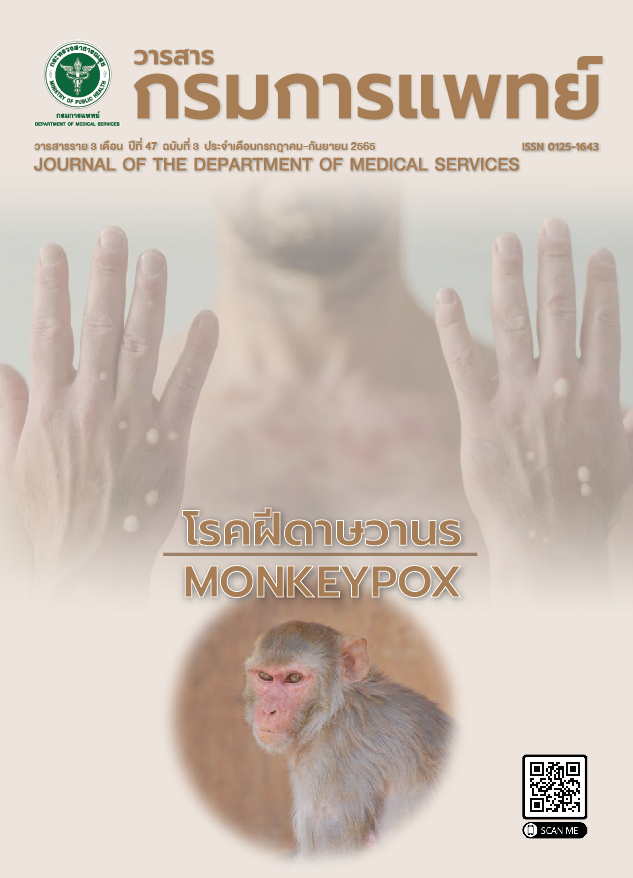Computed Tomography Findings of the Brain in Stroke Fast Track at Thabo Crown Prince Hospital (Pre and Post Thrombolytic Therapy)
Keywords:
Stroke fast track, Acute ischemic stroke, Computed Tomography of the brainAbstract
Background: The incidence of strokes in Thailand has been increasing annually. The stroke fast track network aims to promptly provide intravenous thrombolytic drugs to acute ischemic stroke patients. Objective: To analyze the demographics, clinical presentations, and computed tomography (CT) findings of the brain (pre- and post-thrombolytic therapy) of stroke fast track patients at Thabo Crown Hospital. Method: This retrospective descriptive study was conducted from July 1, 2019, to December 31, 2021. The data were analyzed by descriptive statistics, i.e., percentage and frequency. Result: A total of 52 stroke fast track patients diagnosed with acute ischemic stroke and who underwent intravenous thrombolytic therapy were recruited. The majority sex was male (54%) and 71-90 years old (36.5%). The most frequent clinical presentations were 48.1% of right hemiparesis, followed by left hemiparesis, dysarthria or aphasia, facial palsy, and paresthesia, respectively. The first abnormal CT scan findings (pre-thrombolytic therapy) were obscuration of the lentiform nucleus, loss of the insular ribbon, parenchymal hypodensity, and hyperdense middle cerebral artery, respectively, the same as the second abnormal (post-thrombolytic therapy) findings with 11.5% hemorrhagic transformation. The six patients were normal first CT scan findings (pre-thrombolytic therapy). In contrast, parenchymal hypodensity, followed by obscuration of the lentiform nucleus and hemispheric sulcal effacement, respectively, were found in the second CT scan. Conclusion: The earliest CT finding of stroke fast track patients (pre- and post-thrombolytic therapy) found from this study is obscuration of the lentiform nucleus. At the same time, patients with no abnormal findings on the first CT scan are mostly found with parenchymal hypodensity on the post-thrombolytic CT scan (24 hours later).
References
Ministry of Public Health. Burden of disease and injuries in Thailand. Priority setting for policy 2002: A14-6.
Prasad K, Vibha D, Meenakshi. Cerebrovascular disease in South Asia - Part I: A burning problem. JRSM Cardiovasc Dis 2012; 1: 1-7.
Park TH, Ko Y, Lee SJ, Lee KB, Lee J, Han MK, et al. Identifying target risk factors using population attributable risks of ischemic stroke by age and sex. J Stroke. 2015; 17:302-11.
National Institute of Neurological Disorders and Stroke rt-PA Stroke Study Group. Tissue plasminogen activator for acute ischemic stroke. N Engl J Med. 1995; 333: 1581-7.
Tomura N, Uemura K, Inugami A, Fujita H, Higano S, Shishido F. Early CT finding in cerebral infarction: obscuration of the lentiform nucleus. Radiology 1988; 168: 463-7.
Bozzao L, Bastianello S, Fantozzi LM, Angeloni U, Argentino C, Fieschi C. Correlation of angiographic and sequential CT findings in patients with evolving cerebral infarction. AJNR 1989; 10: 1215-22.
Truwit CL, Barkovich AJ, Gean-Marton A, Hibri N, Norman D. Loss of the insular ribbon: another early CT sign of acute middle cerebral artery infarction. Radiology 1990; 176: 801–6.
Barber PA, Demchuk AM, Hudon ME, Pexman JH, Hill MD, Buchan AM. Hyperdense sylvian fissure MCA "dot" sign A CT marker of acute ischemia. Stroke 2001; 32: 84-8.
Wardlaw JM, Lewis SC, Dennis MS, Counsell C, McDowall M. Is visible infarction on computed tomography associated with an adverse prognosis in acute ischemic stroke? Stroke. 1998; 29: 1315-9.
Patel SC, Levine SR, Tilley BC, Grotta JC, Lu M, Frankel M, et al. Lack of clinical significance of early ischemic changes on computed tomography in acute stroke. JAMA 2001; 286: 2830–8.
Von Kummer R, Allen KL, Holle R, Bozzao L, Bastianello S, Manelfe C, et al. Acute stroke: usefulness of early CT findings before thrombolytic therapy. Radiology 1997; 205: 327-33.
Pressman BD, Tourje EJ, Thompson JR: An early sign of ischemic infarction increased density in the middle cerebral artery. AJNR 1987; 8: 645-8.
Downloads
Published
How to Cite
Issue
Section
License
Copyright (c) 2022 Department of Medical Services, Ministry of Public Health

This work is licensed under a Creative Commons Attribution-NonCommercial-NoDerivatives 4.0 International License.
บทความที่ได้รับการตีพิมพ์เป็นลิขสิทธิ์ของกรมการแพทย์ กระทรวงสาธารณสุข
ข้อความและข้อคิดเห็นต่างๆ เป็นของผู้เขียนบทความ ไม่ใช่ความเห็นของกองบรรณาธิการหรือของวารสารกรมการแพทย์



